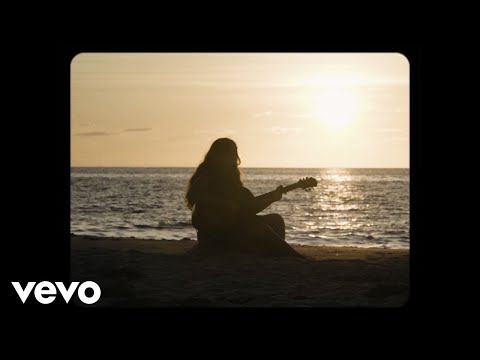For hit singer-songwriter Gigi Perez, Austin City Limits was a graduation
When Gigi Perez took to the stage at the Austin City Limits Festival earlier this month, it felt like the universe was holding up a mirror, reflecting back all the growth she’d done in the four years since her last performance there.
Back in 2021, the Cuban American singer-songwriter had a newly-minted record deal and a handful of viral SoundCloud singles — the wistful acoustic guitar track “Sometimes (Backwood)” and the devastatingly raw “Celene.” The 2021 edition of ACL was the first festival she ever performed, and though her early afternoon slot at one of the smaller stages attracted a few dozen audience members, Perez had spent so many years dreaming of the opportunity that it didn’t matter. She was happy just to be there.
This month, Perez returned to Austin no longer an emerging artist, but as a rising star. Her mega-viral single, the lovesick folk ballad from 2024, “Sailor Song,” had topped the U.K. singles chart and earned more than 1 billion streams on Spotify. On the back of its success, she spent the first half of this year opening for Hozier in support of her 2025 debut LP, “At the Beach, in Every Life.”
So when she took the stage at ACL in October, this time it was for a coveted golden hour set, with a sea of people stretched out before her — and a chorus of voices singing along to her every word.
“It was magical,” Perez told De Los. “There were people there who were actually at my first set in 2021, standing in the front. It meant a lot to me. I think that there’s a shock that I still experience with people coming to my set at a festival.”

At 25 years old, Perez has lived more life than most. Born in New Jersey and raised in West Palm Beach, Fla., the singer grew up in a devoutly Christian Cuban household, the middle child of three sisters.
As a teenager, the religious values she’d been steeped in were beginning to clash with her own realizations about her sexuality — and music provided a lifeline. The queer artists she listened to, like Hayley Kiyoko and Troye Sivan, tapped into feelings she hadn’t been able to articulate, and inspired her to write music that would allow her to express them in her own words.
At 18, just as she was preparing to head to the Berklee College of Music in Boston, her grandmother and uncle passed away, just weeks apart from each other. These dual losses set off a wave of grief and sparked difficult questions about her faith. She was struggling to regain her footing over the next year when, just months into the pandemic, her family experienced the sudden loss of her older sister Celene.
Perez felt unmoored. Her whole life, Celene had been a north star, a guiding light who inspired her to take up music, and who wanted to be a singer herself. Perez did what she knew how: wove her pain and anger and devastation into music, writing the soul-stirring tribute, “Celene.”
“The other day, I thought of something funny, but no one would’ve laughed but you,” she sings. “And mom and dad are always crying. And I wish I knew what to do.”

(Cat Cardenas / For De Los)
Her first original songs gained traction on TikTok, getting the attention of Interscope Records. From there, her career began to take off. She opened for Coldplay and Noah Cyrus, releasing her first EP, “How to Catch a Falling Knife,” in April 2023. Then, just months into a string of performances scheduled in London that summer, the label released her from her contract.
“I remember just being dumbfounded,” she said. “It was this immediate, very deep sense of fear and failure.”
But the funny thing about grief — that all-consuming force that had dragged her out to sea multiple times over the last several years — was that as suffocating as it could be, it was also surprising and unpredictable. So despite the depth of complicated emotions washing over her, Perez was acutely aware that this news was nothing compared to the loss of her sister. “So many things that happen in my life don’t affect me in that same profound way,” she said. “That was one of the things that made me. I don’t know, it’s hard to find the words even now.”
Growing up, Celene had her sights set on Broadway. She introduced Gigi to several musicals, from a bootleg version of “Legally Blonde,” to her first live theater experience in “Wicked,” to the cast album of Lin–Manuel Miranda’s “In the Heights.” They played one song from the soundtrack, “Breathe,” on repeat. It’s sung by the character Nina, the daughter of immigrants in Washington Heights, who returns home in shame after having to drop out of Stanford University.
“That’s how I was feeling at the time,” Perez professed.
In London, she listened to the song on repeat. Then, she started writing. From the beginning, her style has always been instinctual; a freeform jam session where she sits at the piano or with her guitar and just lets her ideas flow out. The title came to her first — “At the Beach, in Every Life” — and the song poured out of her, nearly word for word.
“I remember the first time I played those chords on the piano, I had no idea what was going to happen,” she said. “I just knew something was opening up inside me, but I had no idea how deep the well was going to be, or that I was going to be an artist who gets to travel the world. I just had these desires, these visions, but to really live it is something else.”
After finishing out her commitments in the U.K., she moved back home to Florida. From her childhood bedroom, she began to rebuild. She taught herself music production and kept writing more songs. Without intending to, the puzzle pieces of the last few years of her life began to fall into place, and the grief that had consumed so much of her story finally had an outlet.
“At the Beach, In Every Life” details a breaking down of Perez’s walls. Her sadness and regret washes over tracks like “Sugar Water” and “Crown,” building into fiery passion on “Chemistry” and “Sailor Song,” before cresting into the haunting resolution of the title track that closes it out. It’s a portrait of loss and yearning, made up of vivid recollections from her childhood, her family, and her previous relationships. In short, it’s the album she wishes she could’ve listened to five years ago when her pain seemed insurmountable.
“I had just been operating blind for so long,” she said. “Being able to share my experience of loss in this specific way, it’s something that my 20-year-old self would be in disbelief of. At the time, it was like being without air, the isolation was so suffocating.”
Not long ago, Perez’s sadness could sometimes make her self-conscious. She wanted to share what she was going through, but she also didn’t want to be defined by it. “I didn’t want to be that girl who was always talking about her sister, but there was this very genuine desire to cry out for help, or acknowledge her,” she said. “Everyone is different, but for me, I needed to acknowledge her in order to be well.”

Fans of Gigi Perez at the barricade during her performance at this year’s Austin City Limits Festival in Austin, Texas.
(Cat Cardenas / For De Los)
Now, not even five years later, it feels like she’s finally turned the page and started a new chapter. “I’ve been able to build a life around my grief, and honor the loss of my sister in a way that’s helped me,” she said. “I don’t know exactly what healing should look like, but her death affected me and continues to affect me in these very profound ways. This is the best case scenario for me, because I get to share it with others — that’s one of the things that makes it so difficult to navigate: the feeling that no one understands you.”
“Knowing that we’re not alone has really saved my life,” she said. “I used to be the person thinking, ‘What’s the point of being alive?’ But knowing there are other people with the same question, I know now that we can hold each other’s hands through that. That’s given me a purpose and that helps me continue to move through it.”
In the process of writing the album, Perez found ways to bring both of her sisters along for the ride. There are voice memos from Celene, along with a snippet of her singing on “Survivor’s Guilt.” But there’s also “Sugar Water,” a track she co-wrote with her younger sister, Bella, who joins her onstage to perform the song on tour. “Anyone who has two sisters knows the chaos and intensity that can bring,” she said. “But we loved each other, and we still do. My relationship to what it means to be a woman was shaped by having sisters, and Celene and Bella are the closest reflection that I have of myself.”
Amid this wild, almost unbelievable year, Perez has been grounded by her family’s presence. Her mom is part of her management team, and her dad has joined them on the road.
“There’s something to be said about being in it so much that it’s almost hard to physically feel it on the level you want to,” Perez said. But over the last few weeks, as she’s gotten the opportunity to revisit the places where she first found her footing as a performer, she’s had the opportunity to reflect on just how much she’s grown since then.
For now, she plans on heading back home to Florida once her tour is over to spend time reflecting on everything. “I think that’s when I’ll start to see the confetti fall,” she said. “Life is uncertain, and we never know what it’s going to throw our way, but this was a year that I prayed for. And I think it was a year that a lot of people who love me prayed for too. So for that, I’m very grateful.”







